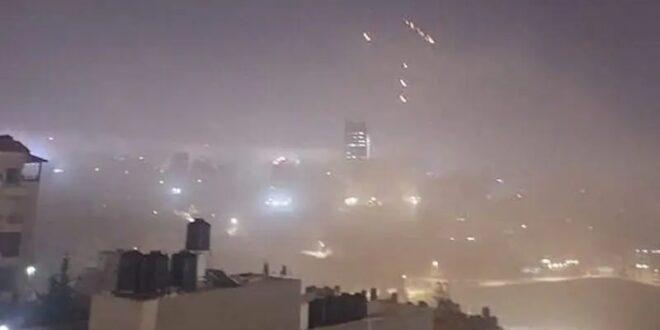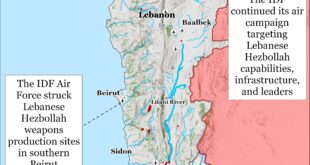On 13 April 2024, Iran’s Islamic Revolutionary Guard Corps (IRGC) launched an aerial attack on Israel involving over 300 drones, cruise and ballistic missiles. Israel and its Western allies including the United States, the United Kingdom, France and neighbouring Jordan were able to organise a coordinated defence using fighter jets, warships, anti-missile and air defence systems intercepting most of the projectiles at the cost of more than US$ 1 billion. At least nine ballistic missiles evaded Israeli defences causing minor damages to Nevatim Air Base in Southern Israel, where Israel’s F-35 fighter jets are based.1
Iran’s Supreme National Security Council issued a statement which noted that Iran had carried out ‘minimum necessary punitive action’ within the framework of the ‘legitimate right of self-defence’ as outlined in Article 51 of the UN Charter. On 1 April 2024, Israeli air strikes had destroyed Iran’s consulate in Damascus killing seven IRGC officers including Quds Force senior-most commander for Syria and Lebanon, Brigadier General Mohammad Reza Zahedi. Since 7 October 2023 Hamas attacks, Israel has intensified its grey-zone attacks targeting the IRGC commanders in Syria and Lebanon with the objective of raising costs for the IRGC for its alleged involvement in targeting Israel. As Maj Gen Yaacov Amidror (Retd) observed, by targeting Iran’s consulate, Israel sent a strong signal to Iran that its continued actions are bringing Israel closer to launching a direct attack on it.2
Iran’s Retaliatory Strikes
The 13 April Iranian strikes against Israel were the first state-on-state attack and therefore entailed a new level of escalation and a significant change in Iran’s deterrence posture. Major General Hossein Salami, the Commander-in-Chief of the IRGC, noted that Iran’s retaliatory strikes have established a new equation with Israel and that if Israel attacked Iranian interests and citizens anywhere, the IRGC will retaliate from Iran. Salami, who served as deputy commander of IRGC until 2019 when he was appointed the Commander-in-Chief, is credited with revision of Iran’s defensive doctrine along the lines of the “strategy of threat against threat” at a time when Iran faced renewed hostility from the United States and Israel under the former US President Donald Trump, who unilaterally withdrew from the Iran nuclear agreement.
The IRGC made first operational use of mid-range missiles in a counter-attack in June 2017 two weeks after ISIS claimed terrorist attacks in Tehran. It launched five to six Zolfaghars, solid-fuelled missiles with a range of some 700 kms from Kermanshah base at ISIS targets in the Deir el-Zour region of eastern Syria. In January 2020, Iran launched short-range missiles at Ayn al Asad and Erbil Air Bases housing US troops in Iraq following the assassination of Quds Force Commander Qasem Soleimani in a US drone attack in Baghdad. In February 2022, after an Unmanned Aerial Vehicle (UAV) raid on a drone manufacturing facility in western Iran, the IRGC launched missiles on what it described as an Israeli ‘spy centre’ near the US consulate in Erbil.
On 16 January 2024, the IRGC carried out coordinated missile strikes by launching 24 Kheibar Shekan precision-guided ballistic missile with a range of 1,450 kms from different locations inside Iran to hit targets in Syria and Iraq. According to Brigadier General Amir Ali Hajizadeh, the commander of the IRGC Aerospace Forces, four Khyber rockets were launched from southern Khuzestan at ISIS’s headquarters in Idlib, and an additional four from Kermanshah, along with seven rockets from East Azerbaijan, targeting the Israeli headquarters in Erbil.3 4
The missiles were launched from the south of the country to test if they could reach the intended range of 1,300 kms. Israeli media noted that by demonstrating the precision-strike capabilities and range of its new ballistic missiles, Iran was sending a message to Israel.5 On 13 April, in the multi-layered Iranian strike on Israel, Kheibar Shekan were the newest and the most advanced missile used together with Shahed-136 Kamikaze drones and Paveh cruise missile which have a range of 1,650 kms.
Iran’s aim was to demonstrate its credible capabilities as well as resolve or risk acceptance in engaging in escalation against a conventionally superior and a nuclear-armed adversary. On the occasion of Iran Army Day on 21 April, Supreme Leader Ayatollah Khamenei stressed that the number of missiles launched or hitting their targets, which has been a focus of the enemy, is secondary.6 The primary issue was demonstrating the emergence of the willpower of the Iranian people and the Armed Forces on the global stage, and this is what has upset the other side.
IRGC Aerospace Forces Commander Hajizadeh noted in an interview that while Israel had mobilised all its military resources to counter Iran’s attacks, Iran had used only minimal capability that is only 20 per cent of what it had prepared to take action against Israel.7 The fact that Iran did not use its more advanced weapons such as Sajjil 2 missile or Fattah hypersonic missiles also underscore Iran’s deterrence strategy designed for different levels of conflict. At the current stage, Iranian attacks were not designed to cause damage, but intended to be a demonstrative measure.
As part of escalation management and to assuage Iran’s neighbouring countries’ concerns about its impending retaliation, Foreign Minister Hossein Abdollahian embarked on a regional tour starting with Oman, which often plays the role of a crucial diplomatic intermediary between Tehran and Washington in times of crisis. At Muscat, Abdollahian stated that in any counter-attacks Iran’s “sole goal in legitimate defence is to punish the Israeli regime” and it was not seeking to expand the conflict in the region. Muscat reportedly relayed Iran’s message to the US that Iranian attacks will be non-lethal and calibrated to target an Israeli military facility.8 Iran also notified its Arab neighbours of its retaliatory strikes on Israel 72 hours in advance, which gave ample time for Israel and its Western allies and regional partners to activate air defences for thwarting impending Iranian strikes.
Israeli Preference for Grey-Zone Attacks
Israeli military claimed that their multi-layered air defence system had successfully intercepted 99 per cent of Iranian drones and missiles. Israel’s European and American allies hailed their ‘defensive victory’, as they pressed Israel for de-escalation. Despite calls for restraint from close allies, Israel’s war cabinet led by Prime Minister Benjamin Netanyahu favoured retaliation. Subsequently, amid the uncertainty about how Israel will retaliate, Iranian President Ebrahim Raisi in his address at Iran’s annual army parade, warned that the “tiniest attack” by Israel would bring a “massive and harsh” response from Iran.9 Israeli counterstrike was therefore aimed at demonstrating Israeli resolve and restore deterrence in the face of Iranian threats.
Israeli media ratcheted up the threat of a strike on Iranian nuclear facilities, leading Iran to temporarily close its nuclear facilities and the International Atomic Energy Agency (IAEA) Director Rafael Grossi urging ‘extreme restraint’ from Israel. On 19 April, Iranian officials insisted that there had been “no air attack from outside borders”, and that three quadcopters were shot down by air defence in Isfahan.10 US officials claimed that Israeli Air Force fired three missiles from outside Iran that hit an air base in Isfahan housing Iran’s fleet of American-made F-14 Tomcats, and an air defence radar site defending Iran’s largest nuclear facility in Natanz.11
While Israel did not publicly take responsibility, the strikes exposed Iran’s vulnerabilities in order to influence Iranian cost-benefit calculus in any further escalation. By continuing with grey-zone tactic of ambiguity about the scale of attacks in Isfahan and plausible deniability about the source of attack, Israel handed Iran an off-ramp for de-escalation. Israel’s decision to not attack Iran’s nuclear facilities may have been shaped by pressure from its Western allies and Arab partners and also the messaging from Iran.
Israel attacking Iranian nuclear facilities would have led to spiral of escalation drawing a massive Iranian response against US interests in the region. On 18 April, a senior IRGC commander in charge of security of nuclear facilities, stated that if
Israel uses the threat of attacking Iran’s nuclear facilities as a tool to put pressure on Iran, it is possible and conceivable to revise Iran’s nuclear doctrine and policies and deviate from the previous declared considerations.12
Maj Gen Amidror (Retd), former National Security Advisor to Prime Minister Netanyahu, describes Iran’s latent capacity to produce nuclear weapons as a key component of Iran’s ‘smart’ strategy for war with Israel. He argues that Iran’s military nuclear capability will serve as an umbrella to ensure that hostile actions against Iran will not be possible, and that Tehran will be able to continue and even expand its aggressive activities throughout the region, mainly against Israel, but also against the United States.13
What the recent exchange of fire has demonstrated is that neither Iran nor Israel can claim escalation dominance that is having decidedly superior capabilities over the other to deter it from engaging in further escalation. However, the controlled or limited escalation by both countries suggest that they are determined to maintain a ‘balance of resolves’, where none is willing to accept the other’s deterrent red lines. Both sides have shown preference for a carefully controlled escalation while avoiding a conflict spiral.
 Eurasia Press & News
Eurasia Press & News


